Biography
Dr Elliot Law is the staff-in-charge of academic matters in the Engineering Design & Innovation Centre and programme coordinator of the Innovation & Design Programme. With a background in Civil Engineering, he supervises a wide range of projects in particular those that are related to structural design, urban mobility, and smart and sustainable cities. He is currently overseeing a number of projects on smart construction, building inspection and maintenance, work automation, and sustainable living in collaboration with a few industry partners. Elliot also works on research in nature-inspired protective structures such as functionally graded honeycombs and fish scale structure composite systems. His areas of expertise include solid mechanics, numerical modelling, and simulations in particular finite element analyses.
Prior to his present appointment, Elliot was a research staff in the Department of Civil & Environmental Engineering where he was involved in the mentoring and supervision of final year undergraduate students, as well as the planning and teaching of undergraduate modules in particular structural analysis and structural steel design. He has also been actively exploring the use of information technology-based systems to improve and enhance student learning.
Elliot is also presently serving as the Assistant Dean for Undergraduate Programmes at the College of Design and Engineering and Deputy Director of the Engineering Design & Innovation Centre.
Educational Background
2012 Doctor of Philosophy, National University of Singapore
2007 Bachelor of Engineering (Civil Engineering), First Class Honours, National University of Singapore
Employment History
Jan 2019 to present: Senior Lecturer, Engineering Design & Innovation Centre, NUS
Mar 2013 to Dec 2018: Lecturer, Engineering Design & Innovation Centre, NUS
Mar 2012 to Feb 2013: Research Fellow, Department of Civil & Environmental Engineering, NUS
Oct 2011 to Feb 2012: Research Engineer, Department of Civil & Environmental Engineering, NUS
Research Interests
Computational mechanics, nature-inspired design, protective structures, structural dynamics, finite element modelling, engineering education
Projects Supervised
Innovations in Intelligent Systems
- Indoor search using swarm of drones
- Drone-based solution for leaf sampling in primary tropical rainforests
Innovating for Better Healthcare
- Innolax: innovative natural laxative
- Print×Lab: A novel device for on-site personalization of drug dosages
- SpenVI: Customised polypills to simplify complex medication regimen
Innovating for Future Mobility
Innovating for Smarter Living
- OnSight: Smart construction solutions
- Vending machine for prototyping components
- Advanced rain screen
- GUIDECK: Semi-automated orientation and positioning system for installation of PPVC modules
- QM-REX: Assistive device for construction workers to perform installation works at height
- FIDbot: An autonomous robot for construction quality checks for floors
- IntelLift: An intelligent self-balancing system for lifting of PPVC modules
- Poseidon: An autonomous solution for watering plants in nurseries
Innovating for Sustainable Cities
- Project Aquamax: minimising feed wastage in coastal fish farms
- Smart food waste recycling system using black soldier fly larvae
- ECO-TIC Acid: from food waste to lactic acid
- Valorising fruit waste: from orange peels to sodium ascorbate
- Credit-based recycling using SMART Bin
- Conversion of household food waste to eco-enzyme
- Growing marine plants on land
- Improving cleanliness of rivers in Singapore
- Turning waste to food: cultivating mushrooms using food-soiled paper
- Sol-Cool: solar-powered evaporative cooling
- Bin Point: Smart recycling on the go
- BINGO: Credit-based plastic recycling for the NUS campus
- Bin Point: A novel approach for promoting recycling in HDB estates
- Verdana: Affordable, effective and risk-free cooling for hostel residents
Selected Research Papers
- Chua YS, Law E, Pang SD and Quek ST (2017). Impact behaviour and design optimization of a ductile scale-cellular composite structure for protection against localized impact. International Journal of Solids and Structures 122: 162-174.
- Chua YS, Law E, Pang SD and Quek ST (2016). Fish scale-cellular composite system for protection against low-velocity impact. Composite Structures 145: 217-225.
- Law E, Pang SD and Quek ST (2012). Effects of particle arrangement and particle damage on the mechanical response of metal matrix nanocomposites: a numerical analysis. Acta Materialia 60(1): 8-21.
- Law E, Pang SD and Quek ST (2011). Discrete dislocation analysis of the mechanical response of silicon carbide reinforced aluminum nanocomposites. Composites Part B: Engineering 41(1): 92-98.


